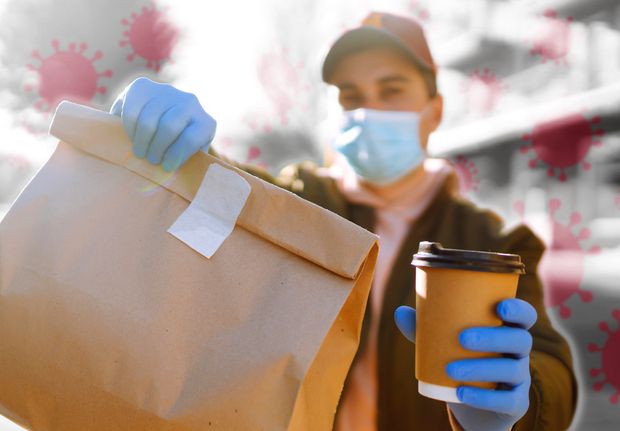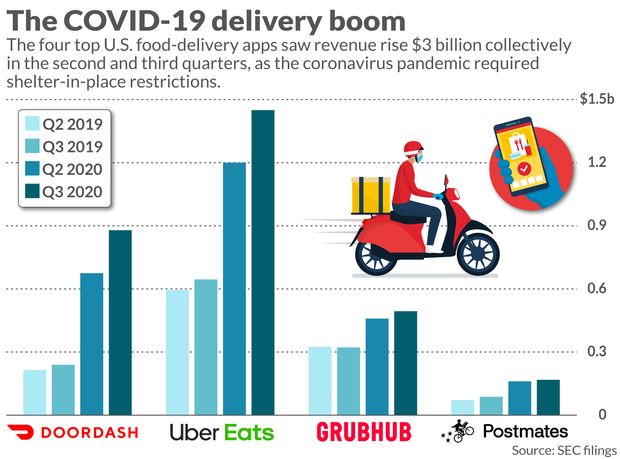
Demand for food delivery has risen dramatically during the COVID-19 crisis.
MarketWatch photo illustration/iStockphoto
Zachary Davis, owner of The Glass Jar restaurant group in Santa Cruz, Calif., said he intentionally avoided working with food-delivery apps before the COVID-19 pandemic because the costs to his business just seemed too high.
But when his county issued shelter-in-place orders, “we were effectively shut down. We closed for a couple of days, took stock and realized it was the only way to keep our business open,” he told MarketWatch.
Davis is not alone. Delivery apps have become more important for both business owners and their customers as more people order takeout and groceries during the coronavirus pandemic. DoorDash Inc.’s DASH, -15.62% recent filing for an initial public offering and earnings reports from Uber Technologies Inc. UBER, -0.89%, Grubhub Inc. GRUB, +1.11% and Postmates have provided a deeper look into delivery apps’ business in 2020, and it is clear the pandemic has given the industry a big boost.
The four companies raked in roughly $5.5 billion in combined revenue from April through September, more than twice as much as their combined $2.5 billion in revenue during the same period last year.

Still unclear is how long the surge in deliveries will last, though, and what it means to the financial success — or lack thereof — of food-delivery apps in the long run. While the companies are seeing a surge in business, their costs remain too high to post any sustained profit. And the other stakeholders involved, such as the restaurants, drivers and cities, are looking to either cap the fees the companies are allowed to charge or to get their fair share of the companies’ revenues.
In the short term, many restaurants have little choice but to sign on with the apps. A Cowen & Co. survey of 2,500 consumers showed that in July, 52% said they would avoid restaurants and bars even after they fully reopen, and a recent rise in COVID-19 cases nationwide means many restaurants are again facing onsite-dining restrictions. According to restaurant-reservation platform OpenTable, the number of seated diners in the U.S. decreased an average of 52% the week of Nov. 19-23.
“Restaurants are heading into a terrifying winter with no lifelines other than delivery platforms,” MKM Partners analysts reported last week.
That is likely to benefit DoorDash, the U.S. industry leader with 50% market share, and the next biggest players: a combined Uber Eats and Postmates, then Grubhub, according to Edison Trends. DoorDash said in its prospectus that its 543 million total orders for the first nine months of the year tripled compared with 181 million orders in the year-ago period.
See: DoorDash IPO: 5 things to know about the app-based food-delivery company
Uber Chief Executive Dara Khosrowshahi was so bullish on delivery that during the company’s second-quarter earnings call, he likened Uber Eats to “another Uber” that the company essentially “built in under three years.” That quarter, Uber Eats brought in more revenue than rides for the first time.
In the third quarter, Uber’s delivery business continued its growth: Uber Eats’ bookings rose 135% year over year, and its revenue surged 125% to $1.45 billion. Uber’s purchase of Postmates, which is expected to close in the fourth quarter of 2020, will bolster its delivery business.
For more: The pandemic turned Postmates’ IPO plans into a bidding war between Uber and Wall Street
Chicago-based Grubhub, which is being acquired by Just Eat Takeaway TKWY, +1.29%, a European company, is also reporting increased business. The company said it had 30 million active diners in the third quarter, a 41% increase from the year-ago period, and its $493.9 million in revenue was 53% more than a year ago.
Beyond takeout, Uber and DoorDash are doubling down on delivery on multiple fronts, increasingly competing with Amazon Inc. AMZN, +2.14%, Walmart Inc. WMT, +0.31% (which has unveiled Walmart Plus, a subscription-delivery service) and other stores that deliver. Ahead of the holidays, DoorDash has rolled out a way for customers to send gifts to others.
The companies are also competing with Instacart, another gig company that delivers groceries. DoorDash recently introduced DashMart, its foray into convenience-store delivery. It has become the official on-demand delivery app of the NBA and brought on more grocery-store partners. Citing growing consumer demand, Uber in the second quarter launched delivery of groceries and goods from convenience stores and pharmacies.
It’s up in the air whether the demand and new offerings will translate into profit. The companies are all largely unprofitable: DoorDash turned a $23 million profit in its second quarter, but it still lost $149 million through the first nine months of this year, according to its prospectus.
“The profitability of the third-party delivery industry still remains a lingering question, with no perspectives offered on when this would be achieved,” Cowen analysts wrote in a research report.
DoorDash said it has lost money in every year of its existence, and expects that to continue. Uber reported that its delivery business lost an adjusted $183 million in the third quarter, an improvement from the $316 million it lost in the year-ago period. Grubhub lost $9.2 million in the third quarter, compared with a $1 million profit in the same period last year.
Some experts believe DoorDash may have an edge on Uber Eats in the race for profitability. James Gellert, chief executive of Rapid Ratings, a company that assesses the finances of private and public companies, points to DoorDash’s “significantly better” margins. He said DoorDash’s financial health is among the best Rapid Ratings has seen among companies going public “in recent history.”
But DoorDash and its competitors continue to face a variety of issues that will affect their financial health. They include pushback from restaurateurs like Davis, who decided to come aboard as a last resort because delivery commissions cut into their profit; dissatisfied couriers; and cities that have capped the commissions apps can collect from struggling restaurants during the pandemic.
“The restaurant industry wants to cap commission,” said Mark Cohen, director of retail studies at Columbia Business School. “The only way to offset this conundrum is to raise the prices of the food. When all is said and done, the consumer is going to pay the price.”
In Santa Cruz, where Davis has three different brands (Penny Ice Creamery, The Picnic Basket and Snap Taco) at five locations, commissions are capped at 15% right now. Several other cities’ caps range from 10% to 20% — lower than the usual 30% that the companies have sought. A recently launched campaign called Protect Our Restaurants is pushing to extend those caps around the nation.
The campaign, led by the American Economic Liberties Project and others, is urging the Federal Trade Commission to investigate the delivery apps’ practices.
“A lot of cities are mobilizing on their own to try to save the restaurant industry,” said Nia Johnson, spokeswoman for the American Economic Liberties Project, in an interview. “What we saw with all these movements was an opportunity to uplift… To really shine a light on the abusive behaviors that are taking place by these corporations.”
Delivery apps say they are actually helping restaurants, especially during the pandemic. Taylor Bennett, global head of public affairs for DoorDash, said in an email that the company “has always focused on empowering local businesses,” and that “supporting restaurants is more critical than ever.”
DoorDash says it has saved restaurants in the U.S., Canada and Australia at least $120 million in commission fees during the pandemic, and that its service has kept many restaurants in business. Grubhub likewise pointed to the $100 million it says it spent on helping restaurants, drivers and diners from April to June, but would not comment on the campaign.
Postmates and Uber Eats have not returned requests for comment on the campaign.
Many couriers who deliver food and other goods for these companies are independent contractors with low pay and little or no benefits. In California, gig companies successfully passed a ballot initiative this month that will ensure they will not have to treat delivery workers as employees — and they’re looking to do the same thing elsewhere.
Read: Uber brands gig companies’ efforts to reshape labor laws as ‘IC+’
Orlando Santana delivers for Instacart and Amazon Flex in the Seattle area, and has also worked for DoorDash and Target Corp. TGT, +1.10% -owned Shipt. He has seen demand for delivery rise during the pandemic as tech workers in the area shifted to working from home. But like other app-based delivery workers, he said he has seen his earnings decline, especially as some customers have stopped tipping on some of the apps. Each day, he tries to get to Amazon Flex first, where he said base pay is $18 an hour and he almost always gets tipped. By contrast, his minimum pay on Instacart is just $7.
But “you kind of just have to take what’s there,” said Santana, a former newspaper employee who now does freelance graphics and photography work along with deliveries.
Josette Sonceau delivered for DoorDash in Charlotte, N.C., for more than two years before she stopped because of health issues that could be exacerbated by the pandemic. She said at first, she delivered only on weekends. When she saw her earnings increase, she started to work weekdays, too, for up to 25 hours a week. Then, “around fall last year, I began seeing $2 and $3 orders.”
Sonceau has lent her voice to a PayUp, a gig-worker campaign, which among other things talks about how tipping can leave low-paid workers in the lurch. “Changes to the system are long overdue that offer a fair wage for all workers so no one must rely on tips,” she said.
DoorDash this week reached a $2.5 million settlement with the District of Columbia over claims it misled customers and skimmed tips intended for its delivery workers between 2017 and 2019. DoorDash has since revised its tip policy.
The labor issues bring legal and regulatory scrutiny — places like San Francisco have sued the companies and the state of California passed a law, which the just-passed ballot initiative will render moot — but they also bother some restaurant owners who use the apps.
“As an employer who cares deeply about my staff and who is always looking for ways to support them, I find the efforts of the delivery-app companies to push labor costs back onto ‘independent contractors’ to be deplorable,” Davis said. He is intrigued by the possibility of teaming up with other restaurant owners to form their own delivery network, but acknowledges that the reach of the apps and the sophistication of their infrastructures would be hard to replicate.
Even if the gig companies manage to secure their business model and avert having to classify their workers as employees everywhere, they will still be adding some labor costs as they offer compromises that fall short of full employee benefits. They have indicated that they will pass those costs on to their customers. For example, DoorDash in its prospectus said changes in California could lead it to charge higher fees and commissions.
“Everybody who’s doing well is doing well at someone else’s expense,” said Cohen from Columbia Business School.










Add Comment